Haswell Z87 Motherboard Preview: 50+ Motherboards from ASUS, Gigabyte, ASRock, MSI, ECS, Biostar and EVGA
by Ian Cutress on May 22, 2013 5:00 PM ESTMSI Z87
MSI have kept their cards relatively close to their chest on this one, except for one microsite detailing the core of their gaming and overclocking range. So far we have details on:
MSI Z87-GD65 Gaming
MSI Z87 MPower
MSI Z87 MPower Max
MSI Z87 XPower
It seems that the Big Bang moniker is finally gone, with MPower being the mid-range overclocking motherboard and the XPower being used for those sub-zero extremists.
MSI Z87A-GD65 Gaming
It was not too long ago that we had a look at the Z77A-GD65 Gaming, whereby MSI described to us that the Gaming range was initially intended for Haswell launch, but due to the extra delay added on by Intel they decided to forge ahead with a Z77 model. Back with that model, there was various limitations on what they could do (either physical or temporal), but Z87 has brought some of them out. Looking at the board we see larger heatsinks for the VRM and the Dragon, as well as Audio Boost:
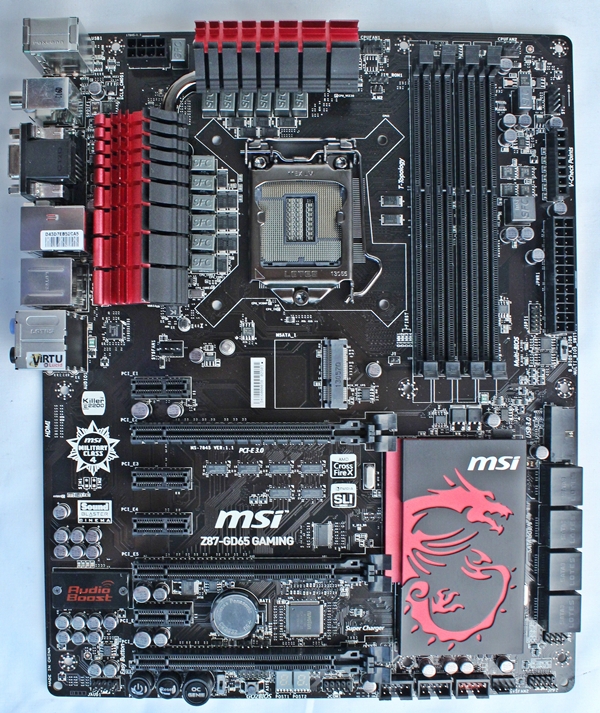
I was initially fooled by the lines on the board with the mSATA, thinking it was something special, but the fastener for the screw means that it is only an mSATA port. The big thing on the left hand side of the board is obviously Audio Boost, which given the motherboards already seen in this preview I would hazard a guess at an ALC1150 hiding under an EMI shield. The microsite states support for 600 ohm headphones as well.
On the board itself we see MSI voltage checkpoints, eight SATA 6 Gbps (it seems all are coming from the chipset?!), the classic OC Genie, also Go2BIOS for Windows 8 users/overclockers. Multi-BIOS also makes an appearance, selectable by a BIOS switch.
MSI Z87 MPower / MPower Max
Source: 59hardware, PC Authority
MSI seems to be splitting their overclocking motherboards into two groups – MPower for the lower cost 24/7 overclocking, and XPower for extreme overclock users. For the MPower, two versions are being released – a normal version and a MAX version. These two boards look very similar, and without close inspection we might miss the differences between them.
The MPower Max:
The MPower:
The differences I can fathom are a slightly rearranged audio layout, moving the two-digit debug from the corner to below the 24-pin ATX connector, the fan headers being slightly rearranged and the OC Genie button moved. Nevertheless on both boards we get Audio Boost, voltage check points, eight SATA ports, what looks like an x8/x4/x4 PCIe layout, an mSATA in the idle of the board, a ClearCMOS button at the back and what looks like space for an extra card on the rear IO. In fact some of the images on the MSI Microsite suggest that this is an 802.11n card – this means the Max might have the card and the normal MPower may not as a price point differentiator.
MSI Z87 XPower
MSI have kept the Z87 XPower very close to their chest. The only images we have are mild corner or socket focused images, but nonetheless it offers potential. At least we can see a big yellow X on there:
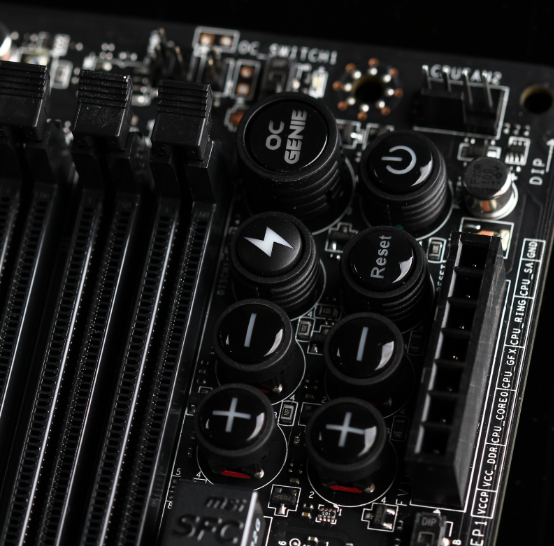
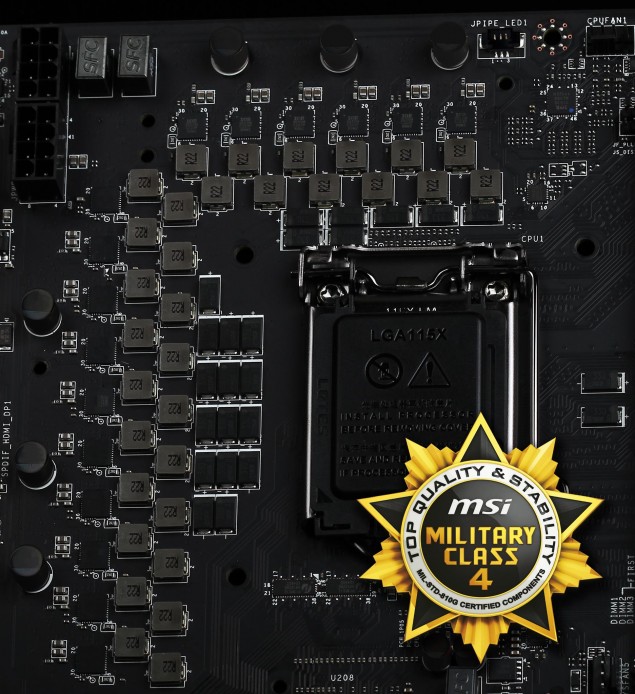
Source: WCCFTech
Biostar Z87
Source: GamersNexus, Hardware.info
During our time on Z87, Biostar never really jumped into the picture. There were murmurings of their Puro audio solution, using pairs of large caps to help filter out analog signals. When it comes to the new Haswell generation, we got wind of several boards coming to market:
Biostar Hi-Fi B85S3 (mATX)
Biostar Hi-Fi H87S3+ (mATX)
Biostar Hi-Fi Z87W
Biostar Hi-Fi Z87X 3D
Gone are the years of orange Biostar boards – whereas everyone seems to be moving away from blue, Biostar are bringing it back with their higher end range.
Biostar Hi-Fi B85S3
First up is a B85 board in a micro-ATX form factor:
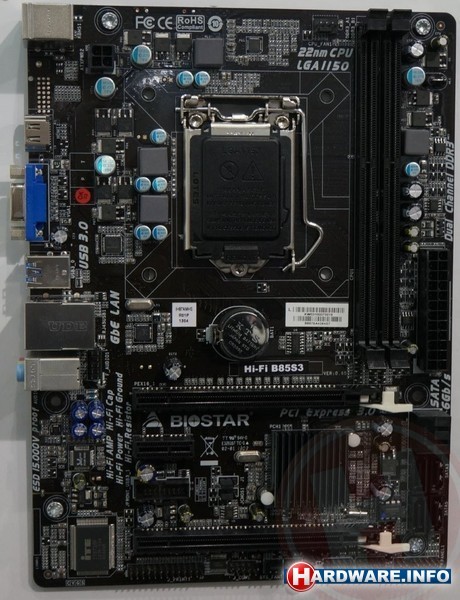
While Biostar are keen to announce the use of USB 3.0, the LGA1150 socket, PCIe 3.0, SATA ports and DDR3, the text relating the audio interests me more. Here we have ‘Hi-Fi AMP’, ‘Hi-Fi Cap’, ‘Hi-Fi Power’, ‘Hi-Fi Ground’ and ‘Hi-Fi Receiver’, which could mean we have a half decent audio solution on a cheap end board, but I would not hold my breath – judging by the three audio outputs we probably have an ALC889 onboard.
The PCIe layout suggests an x16/x1/x1/x4 layout due to the B85 chipset, and the SATA ports have two upright and four coming out of the board. The Rear IO looks a little bare but we clearly have a HDMI, VGA, and a few USB 3.0 ports.
Biostar Hi-Fi H87S3+
Moving up the chain to H87 we have a similar looking board to examine, especially in terms of IO.
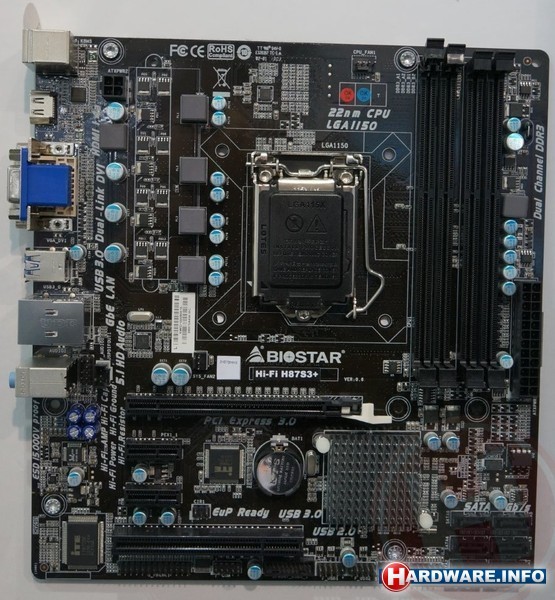
The PCIe lane allocation is sporting a PCI connector at the bottom, and the SATA ports (there seems to be six under the logo) are all coming out of the board. The audio solution still looks like an ALC889 however. On the IO the VGA looks like it is now above a DVI connector.
Biostar Hi-Fi Z87W
The full ATX models from Biostar are starting to actually look nice, rather than the orange of yesteryear. The Z87W comes in focused all within the Puro Hi-Fi:

So Puro was on Z77 but unfortunately we did not have a deep look at it. With Z87 I do hope they are using the ALC1150 as well as supporting 600 ohm headphones, though without technical specifications I can only speculate. Biostar have never been one for multi-GPU setups, but we get what looks like an x8/x8 allocation on the GPUs, as well as power/reset buttons and a two-digit debug LED.
Biostar Hi-Fi Z87X 3D
Another step up the ladder and we get a clear shot of the next motherboard up the range, the Z87X 3D.
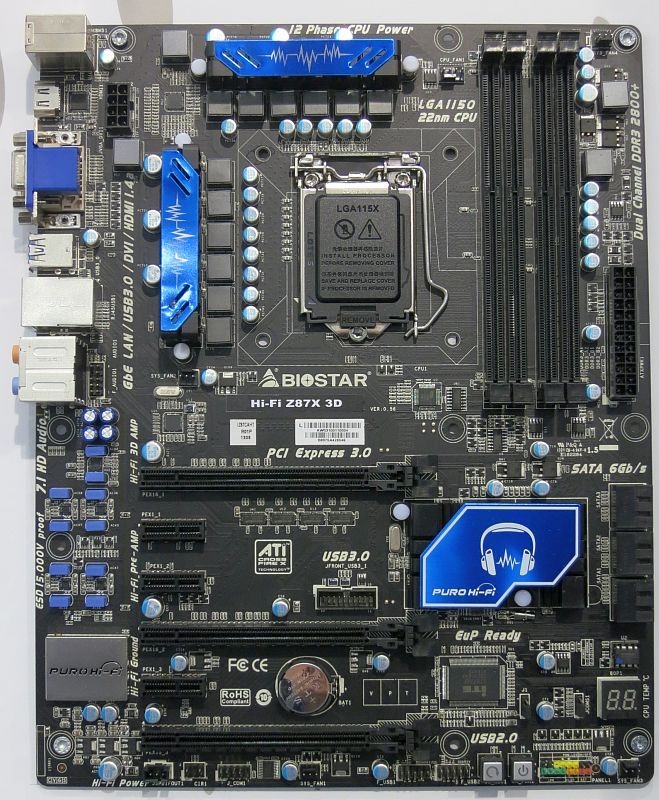
We can see Biostar are slowly upping the number of phases for the CPU (it states on the top of the board 12), and the Puro Hi-Fi takes up a good portion of the left hand side of the board. PCIe allocation looks like an x8/x4/x4 (or x8/x8 + x4), and we get proper power/reset buttons this time around. It is worth noting the very strange location of the USB 3.0 connector – right in the middle of the motherboard. This means a cable stretched across the board, and no luck if you decide to use a triple slot GPU or large PCIe x1 card.
EVGA Z87
With most of the recent releases, EVGA has not been a big player on release day, typically only releasing one or two products with up to three or four motherboards per chipset in total - for example on Z77 we had the FTW and the Stinger. I was lucky enough to catch one of Jacob Freeman’s tweets today showing off their Z87 motherboard:
It looks like we have a new BIOS, that the EVGA board is, as always, looking substantial in terms of heatsinks and PCIe. EVGA employ K¦ngp¦n, one of the world’s top overclockers, who constantly uses EVGA boards to break overclocking world records when he can. Of course I would like to see what EVGA have up their sleeve for this generation.


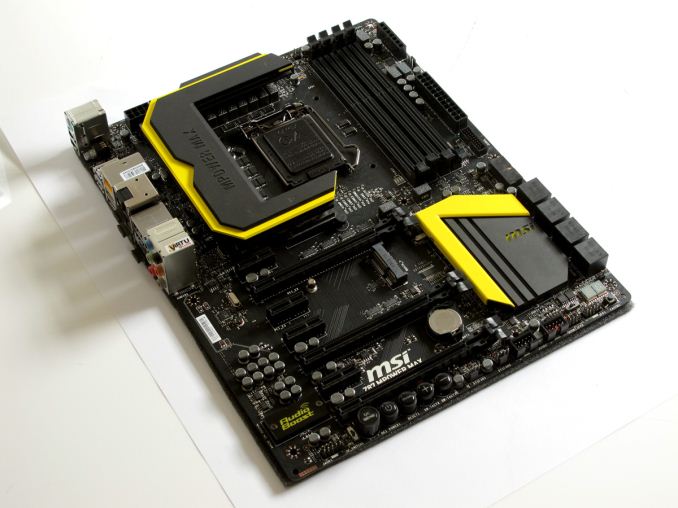
_575px.jpg)







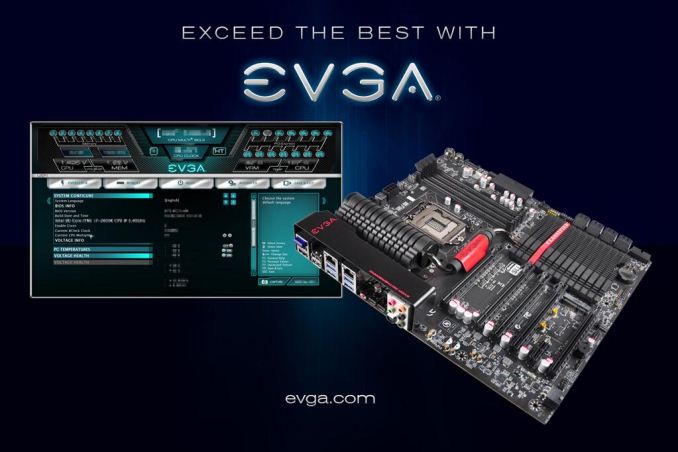








70 Comments
View All Comments
austinindallas - Thursday, May 23, 2013 - link
the asrock z77 extreme 4 was my very first experience with asrock, but i am VERY satisfied with it. and it was a GREAT price compared to othersSm0kes - Friday, May 24, 2013 - link
Better than SATA II speeds on the mSATA port. Not sure why it was gimped on the z77e-itx.mutantmagnet - Tuesday, May 28, 2013 - link
The build quality is fine. An article posted by Gigabyte was comparing the failure rate of the various motherboard makers (which they got first place last year) didn't make me think any motherboard manufacturer was significantly behind the others to single any of them out as bad.crimson117 - Wednesday, May 22, 2013 - link
Asus summary:Channel boards:
ASUS Z87-C
ASUS Z87-A
ASUS Z87-Plus (y u no A+?)
ASUS Z87-Pro
ASUS Z87-Deluxe
Specific purpose boards:
ASUS Z87-WS (for workstations)
ASUS Z87-ITX (mITX) (for mITX cases)
Enthusiast boards:
ASUS Sabertooth Z87
ASUS ROG Maximus VI Hero
ASUS ROG Maximus VI Extreme
mATX Enthusiast:
ASUS Gryphon Z87 (mATX)
ASUS ROG Maximus VI Gene (mATX)
While I'm cautiously optimistic that they've improved over their indecipherable Z77 naming schemes, I'm taking bets regarding how long it will be until the L, LK, ML, FJ, WJK, MS, JK, and YOLO variants show up and confuse everyone.
c0pperbottoms - Wednesday, May 22, 2013 - link
How about a micro-ATX board where I can have 2 dual-slot GPUs in 16x slots where the damned PCI or PCI-E 1x slot is ABOVE the GPUs so I can have a sound card (or some other accessory for that mattter)??meacupla - Wednesday, May 22, 2013 - link
Because most mATX cases sport 4 slots, not 5?You might as well buy an ATX board and ATX case if you're going to go out of your way to buy an mATX case that has 5 slots and would also be undoubtedly large.
This Guy - Thursday, May 23, 2013 - link
I want a small, quite computer but already have an expensive sound card and need crossfire/sli to run my monitors. The Corsair Obsidian 350D looks well suited to my wants and I was thinking about getting a Z87 version of the Gigabyte D3H. A few Noctura's and it will been silent except when gaming.Death666Angel - Wednesday, May 22, 2013 - link
Well, for x16 in dual GPU configuration, you need S2011. Haswell only provides enough for x8 in dual GPU configuration. But I think you are just meaning x8/x8 for 2 GPUs.Look at the
Gigabyte G1.Sniper M5
It gives you x8/x1/x4/x8 slots where you can have a dual slot graphics card in the first x8, then a PCIe in the x4 and a dual/triple slot graphics card in the last x8.
c0pperbottoms - Wednesday, May 22, 2013 - link
Actually I did mean two 16x, but thanks for clarifying. Not yet very well read on Haswell. Also it occurs to me that we're not really bumping up against the (admittedly negligible) bandwidth constraints of PCIE-2 anymore, so two 8x aren't really of a problem :)There are a number of micro-ATX cases that sport 5 slots... They're still smaller than a mid-tower full-up ATX case.
alwayssts - Thursday, May 23, 2013 - link
I'm with you on this...it's funny how many people want what we do. Here is my plan:I use a PC-C50b because I agree Matx in the most sensible form-factor these days. The case can house a Noctua C14 and still fit in an entertainment rack, what else do you really need? I would not call it exceptionally large. Case has 4 CONVENTIONAL slots...but a fifth at an angle so you could use with a flexible riser.
http://www.lian-li.com/v2/en/product/product06.php...
I very well might find myself going dual-GPU as soon as 4k60 connectivity and televisions are a consumer reality...but I know I will want one of those spiffy ROG pci-e SSDs. I suppose SATA will be a reality at some point around that time, but we'll see.
I really wish the cards could sit next to each other because the riser slot is perpendicular, and will probably be pretty terrible for a graphics card...but that's how it has to be.